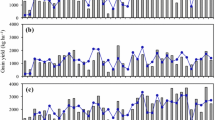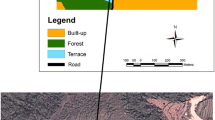Abstract
Because of human dependence on sustainable food production, it is needed to adopt agricultural production to climate change, and their consequences on associated socioeconomic issues. Crop modelling potentially can contribute to global food and nutrition security. Therefore, in this context DSSAT (decision support system for agro-technology transfer) was validated for predicting growth and yield of wheat under a diverse semi-arid climate (2 years with diverse climates) and different irrigation strategies, planting methods, and nitrogen rates. The irrigation strategies were ordinary furrow irrigation (OFI) and variable alternate furrow irrigation (VAFI), and the planting methods were on-ridge planting (ORP) and in-furrow planting (IFP) methods. The fertilizer levels were 0 (N0), 150 (N1) and 300 (N2) kg N ha−1. Results indicated that water stress and inappropriate weather especially during the stem elongation influences the grain yield remarkably without noticeable effect on straw yield. Furthermore, VAFI strategy did not impose any limitation on top dry matter N concentration in both years. Calibration of DSSAT showed that the model underestimated the actual evapotranspiration at the end of growing season (during spring with high temperature) and resulted in overestimating the soil water content at depths under 10 cm during this period of time. Since the potential transpiration has an important role in calculating the effect of water stress factor, the model overestimated slightly the maximum leaf area index (LAI) and consequently biomass and yield in water stress condition; however, overall, model could statistically simulate LAI (NRMSE = 0.3, d = 0.96, R2 = 0.95), total dry matter (NRMSE = 0.07, d = 0.99, and R2 = 96) and grain yield (NRMSE = 0.13, d = 0.96, and R2 = 90). Model also could reasonably simulate the nitrogen components including the grain N concentration (NRMSE = 0.05, d = 0.95), above-ground nitrogen uptake (NRMSE = 0.11, d = 0.99), and soil nitrate content (NRMSE = 0.23, d = 0.86). However, evaluating the model with data set from 2015 to 2016 indicated that the model could not simulate wheat yield and nitrogen components in validation year due to strong effects of diverse weather condition and water stress on grain yield and crop development.













Similar content being viewed by others
References
Ahmadi, S. H., Andersen, M. N., Lærke, P. E., Plauborg, F., Sepaskhah, A. R., Jensen, C. R., et al. (2012). Interaction of different irrigation strategies and soil textures on the nitrogen uptake of field grown potatoes. International Journal of Plant Production,5(3), 263–274.
Ahmed, M., Akram, M. N., Asim, M., Aslam, M., Hassan, F. U., Higgins, S., et al. (2016). Calibration and validation of APSIM-Wheat and CERES-Wheat for spring wheat under rainfed conditions: models evaluation and application. Computers and Electronics in Agriculture,123, 384–401.
Allen, R. G., Pereira, L. S., Raes, D., & Smith, M. (1998). Crop evapotranspiration: guidelines for computing crop water requirements FAO Irrigation and Drainage Paper No. 56. Rome: United Nations FAO.
Andarzian, B., Hoogenboom, G., Bannayan, M., Shirali, M., & Andarzian, B. (2015). Determining optimum sowing date of wheat using CSM-CERES-Wheat model. Journal of the Saudi Society of agriculTural Sciences,14(2), 189–199.
Asseng, S., Ewert, F., Rosenzweig, C., Jones, J. W., Hatfield, J. L., Ruane, A. C., et al. (2013). Uncertainty in simulating wheat yields under climate change. Nature Climate Change,3(9), 827.
Barzegari, M., Sepaskhah, A. R., & Ahmadi, S. H. (2017). Irrigation and nitrogen managements affect nitrogen leaching and root yield of sugar beet. Nutrient Cycling in Agroecosystems,108, 211–230.
Basso, B., Liu, L., & Ritchie, J. T. (2016). A comprehensive review of the CERES-wheat,-maize and-rice models’ performances. Advances in Agronomy,136, 27–132.
Bassu, S., Brisson, N., Durand, J. L., Boote, K., Lizaso, J., Jones, J. W., et al. (2014). How do various maize crop models vary in their responses to climate change factors? Global Change Biology,20(7), 2301–2320.
Boote, K. J., Porter, C., Jones, J. W., Thorburn, P. J., Kersebaum, K. C., Hoogenboom, G., et al. (2015). Sentinel site data for crop model improvement definition and characterization, improving modeling tools to assess climate change effects on crop response. Madison: ASA–CSSA–SSSA Inc.
Chapman, H. D., & Pratt, P. F. (1961). Method of analysis for soil, plants and waters. Berkeley: UC Division of Agriculture.
DeJonge, K. C., & Thorp, K. R. (2017). Implementing standardized reference evapotranspiration and dual crop coefficient approach in the DSSAT cropping system model. Transactions of the ASABE,60(6), 1965–1981.
Dhawan, A. K. (2017). Proceedings of national conference on climate change and agricultural production: adapting crops to climate variability and uncertainty (April 6–8, 2017). Excel India Publishers, New Delhi.
Fant, C. A., Gueneau, A., Strzepek, K., Awadalla, S., Farmer, W., Blanc, E., Schlosser, C. A. (2012). CliCrop: a crop water-stress and irrigation demand model for an integrated global assessment model approach. MIT joint program on the science and policy of global change.
Godwin, D. C., & Singh, U. (1998). Nitrogen balance and crop response to nitrogen in upland and lowland cropping systems. In G. Y. Tsuji, G. Hoogenboom, & P. K. Thornton (Eds.), Understanding options for agricultural production. Systems approaches for sustainable agricultural development (Vol. 7). Dordrecht: Springer.
Hunt, L. A., & Boote, K. J. (1998). Data for model operation, calibration, and evaluation. In G. Y. Tsuji, G. Hoogenboom, & P. K. Thornton (Eds.), Understanding options for agricultural production. Systems approaches for sustainable agricultural development (Vol. 7). Dordrecht: Springer.
Hunt, L. A., & Pararajasingham, S. (1995). CROPSIM-WHEAT: a model describing the growth and development of wheat. Canadian Journal of Plant Science,75(3), 619–632.
Hussain, J., Khaliq, T., Ahmad, A., & Akhtar, J. (2018). Performance of four crop model for simulations of wheat phenology, leaf growth, biomass and yield across planting dates. PLoS One,13(6), e0197546.
Jones, J. W., Hoogenboom, G., Porter, C. H., Boote, K. J., Batchelor, W. D., Hunt, L. A., et al. (2003). The DSSAT cropping system model. European Journal of Agronomy,18(3–4), 235–265.
Kassie, B. T., Asseng, S., Porter, C. H., & Royce, F. S. (2016). Performance of DSSAT-Nwheat across a wide range of current and future growing conditions. European Journal of Agronomy,81, 27–36.
Mehrabi, F., & Sepaskhah, A. R. (2018). Interaction effects of planting method, irrigation regimes, and nitrogen application rates on yield, water and nitrogen use efficiencies of winter wheat (Triticum aestivum). International Journal of Plant Production,12(4), 265–283.
Mehrabi, F., & Sepaskhah, A. R. (2019). Partial root zone drying irrigation, planting methods and nitrogen fertilization influence on physiologic and agronomic parameters of winter wheat. Agricultural Water Management,223, 105688.
Molden, D., Oweis, T., Steduto, P., Bindraban, P., Hanjra, M. A., & Kijne, J. (2010). Improving agricultural water productivity: between optimism and caution. Agricultural Water Management,97(4), 528–535.
Nain, A. S., Dadhwal, V. K., & Singh, T. P. (2004). Use of CERES-Wheat model for wheat yield forecast in central Indo–Gangetic Plains of India. Journal of Agricultural Science,142(1), 59–70.
Nielsen, D. C., Ma, L., Ahuja, L. R., & Hoogenboom, G. (2002). Simulating soybean water stress effects with RZWQM and CROPGRO models. Agronomy Journal,94(6), 1234–1243.
Oteng-Darko, P., Yeboah, S., Addy, S. N. T., Amponsah, S., & Danquah, E. O. (2013). Crop modeling: a tool for agricultural research–A. Journal of Agricultural Research Development.,2(1), 001–006.
Palosuo, T., Kersebaum, K. C., Angulo, C., Hlavinka, P., Moriondo, M., Olesen, J. E., et al. (2011). Simulation of winter wheat yield and its variability in different climates of Europe: a comparison of eight crop growth models. European Journal of Agronomy,35(3), 103–114.
Priestley, C. H. B., & Taylor, R. J. (1972). On the assessment of surface heat flux and evaporation using large-scale parameters. Monthly Weather Review,100(2), 81–92.
Razzaghi, F., & Sepaskhah, A. R. (2012). Calibration and validation of four common ET0 estimation equations by lysimeter data in a semi-arid environment. Archives of Agronomy and Soil Science,58(3), 303–319.
Reynolds, M., Kropff, M., Crossa, J., Koo, J., Kruseman, G., Molero Milan, A., et al. (2018). Role of modelling in international crop research: overview and some case studies. Agronomy Journal,8(12), 291.
Ritchie, J. T. (1991). Wheat phasic development. In R. J. Hanks & J. T. Ritchie (Eds.), Modeling plant and soil systems. Agron. Monogr. 31 (pp. 31–54). Madison: ASA, CSSA, and SSSA.
Ritchie, J. T., Singh, U., Godwin, D. C., & Bowen, W. T. (1998). Cereal growth, development and yield. In G. Y. Tsuji, G. Hoogenboom, & P. K. Thornton (Eds.), Understanding options for agricultural production. Systems approaches for sustainable agricultural development (Vol. 7). Dordrecht: Springer.
Sepaskhah, A. R., & Hosseini, S. N. (2008). Effects of alternate furrow irrigation and nitrogen application rates on yield and water-and nitrogen-use efficiency of winter wheat (Triticum aestivum L.). Plant Production Science,11(2), 250–259.
Sepaskhah, A. R., & Tafteh, A. (2012). Yield and nitrogen leaching in rapeseed field under different nitrogen rates and water saving irrigation. Agricultural Water Management,112, 55–62.
Shabani, A., Sepaskhah, A. R., & Kamgar, H. A. (2013). Responses of agronomic components of rapeseed (Brassica napus L.) as influenced by deficit irrigation, water salinity and planting method. International Journal of Plant Production,7(2), 1735–8043.
Shahrokhnia, M. H., & Sepaskhah, A. R. (2016). Effects of irrigation strategies, planting methods and nitrogen fertilization on yield, water and nitrogen efficiencies of safflower. Agricultural Water Management,172, 18–30.
Singh, A. K., Tripathy, R., & Chopra, U. K. (2008). Evaluation of CERES-Wheat and CropSyst models for water–nitrogen interactions in wheat crop. Agricultural Water Management,95(7), 776–786.
Slatni, A., Zayani, K., Zairi, A., Yacoubi, S., Salvador, R., & Playán, E. (2011). Assessing alternate furrow strategies for potato at the Cherfech irrigation district of Tunisia. Bioprocess and Biosystems Engineering,108(2), 154–163.
Soltani, A., & Sinclair, T. R. (2015). A comparison of four wheat models with respect to robustness and transparency: simulation in a temperate, sub-humid environment. Field Crops Research,175, 37–46.
Tafteh, A., & Sepaskhah, A. R. (2012). HYDRUS-1D model for simulating water and nitrate leaching from continuous and alternate furrow irrigated rapeseed and maize fields. Agricultural Water Management,113, 19–29.
Thind, H. S., Buttar, G. S., & Aujla, M. S. (2010). Yield and water use efficiency of wheat and cotton under alternate furrow and check-basin irrigation with canal and tube well water in Punjab, India. Irrigation Science,28(6), 489–496.
Thorp, K. R., Hunsaker, D. J., French, A. N., White, J. W., Clarke, T. R., & Pinter, P. J., Jr. (2010). Evaluation of the CSM-CROPSIM-CERES-Wheat model as a tool for crop water management. Transactions of the ASABE,53(1), 87–102.
Tisdale, S. L., Havlin, J. L., Beaton, J. D., & Nelson, W. L. (1999). Soil fertility and fertilizers: an introduction to nutrients management (6th ed., p. 109). New Jersey: Prentice Hall.
White, J. W., Alagarswamy, G., Ottman, M. J., Porter, C. H., Singh, U., & Hoogenboom, G. (2015). An overview of CERES–sorghum as implemented in the cropping system model version 4.5. Agronomy Journal,107(6), 1987–2002.
Willmott, C. J., Ackleson, S. G., Davis, R. E., Feddema, J. J., Klink, K. M., Legates, D. R., et al. (1985). Statistics for the evaluation and comparison of models. Journal of Geophysical Research: Oceans,90(C5), 8995–9005.
World Health Organization. (2018). The state of food security and nutrition in the world 2018: building climate resilience for food security and nutrition. Rome: Food and Agriculture Org.
Yarami, N., & Sepaskhah, A. R. (2015). Saffron response to irrigation water salinity, cow manure and planting method. Agricultural Water Management,150, 57–66.
Zheng, Z., Cai, H., Yu, L., & Hoogenboom, G. (2017). Application of the CSM–CERES–Wheat Model for yield prediction and planting date evaluation at Guanzhong Plain in Northwest China. Agronomy Journal,109(1), 204–217.
Zlatko, S., & Zdenko, R. (2005). Canola cultivars differ in nitrogen utilization efficiency at vegetative stage. Field Crop Research,97, 221–226.
Acknowledgements
This research supported in part by a research project funded by Grant no. 98-GR-AGR 42 of Shiraz University Research Council, Drought Research Center, the Center of Excellent for On-Farm Water Management, and Iran National Science Foundation (INSF).
Author information
Authors and Affiliations
Corresponding author
Rights and permissions
About this article
Cite this article
Mehrabi, F., Sepaskhah, A.R. Winter Wheat Yield and DSSAT Model Evaluation in a Diverse Semi-Arid Climate and Agronomic Practices. Int. J. Plant Prod. 14, 221–243 (2020). https://doi.org/10.1007/s42106-019-00080-6
Received:
Accepted:
Published:
Issue Date:
DOI: https://doi.org/10.1007/s42106-019-00080-6




